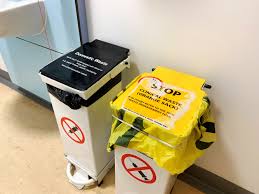Clinical waste disposal is an essential component of healthcare facilities, ensuring the safe and efficient management of waste materials generated in hospitals, clinics, laboratories, and other medical environments. These facilities generate a wide variety of waste, some of which can be hazardous to human health and the environment. With the increasing amount of clinical waste being produced globally, the need for effective, safe, and environmentally friendly disposal solutions is more crucial than ever.
Technology has played a significant role in revolutionizing the way clinical waste is handled. In recent years, advancements in various technologies have improved the processes of waste management, from collection to disposal. These innovations not only increase the efficiency of clinical waste disposal but also enhance safety, reduce costs, and contribute to environmental sustainability. This article will explore the role of technology in modern clinical waste disposal solutions and how it is shaping the future of healthcare waste management.
The Need for Efficient Clinical Waste Disposal
Before delving into the technological advancements in waste disposal, it is important to understand why efficient and safe clinical waste disposal is so critical. Clinical waste includes items such as needles, syringes, surgical instruments, contaminated bandages, drugs, chemicals, and other materials that may be infected or toxic. If mishandled, these materials can lead to contamination, disease transmission, injuries, and environmental damage.
Proper waste disposal is not just a legal or regulatory requirement; it is an ethical responsibility for healthcare providers. The improper disposal of clinical waste can lead to health hazards for patients, medical staff, and the public. Additionally, it can contribute to environmental pollution, which is a growing concern globally. As healthcare facilities continue to generate more waste, the importance of advanced solutions becomes more evident.
The Integration of Technology in Clinical Waste Disposal
Modern clinical waste disposal solutions have embraced a range of technologies that improve the safety, efficiency, and sustainability of waste management practices. These technologies span the entire waste disposal process—from collection and segregation to transportation and final disposal.
1. Waste Segregation and Identification Technology
Effective clinical waste management begins with proper waste segregation. Different types of waste require different handling and disposal methods. For example, sharps (such as needles and scalpels) need to be disposed of in special containers to prevent injuries, while pharmaceutical waste requires specific treatments to neutralize harmful chemicals.
Technology has improved the process of waste segregation by using automated systems that help healthcare workers separate waste based on its classification. Radio frequency identification (RFID) tags and barcodes are increasingly being used to label and track medical waste. These tags allow for the identification and categorization of clinical waste items before disposal, reducing the chances of mixing hazardous and non-hazardous materials.
In addition to these tagging systems, advanced software solutions can analyze waste data to ensure that it is being correctly categorized and processed. By reducing human error in waste segregation, these technologies help maintain regulatory compliance and minimize the risks associated with improper disposal.
2. Smart Collection Systems
Once clinical waste has been segregated, it must be collected and transported to a disposal site. Traditional methods of waste collection often involve manual handling, which increases the risk of exposure to hazardous materials and injuries. However, technology has introduced smart collection systems that enhance safety and efficiency.
For example, automated waste collection systems use sensors and pneumatic tubes to transport waste safely from various parts of a healthcare facility to central collection points. These systems reduce the need for manual handling and allow for faster and more hygienic collection. Additionally, the use of real-time monitoring systems helps track the waste as it moves through the collection process, ensuring that it does not get misplaced or mishandled.
Smart waste collection systems can also be integrated with waste management software, providing healthcare facilities with real-time data on waste volume, types, and disposal frequency. This allows for better resource allocation and streamlining of the waste management process.
3. Waste Treatment Technology
One of the most critical stages in clinical waste disposal is the treatment of hazardous materials to render them safe for disposal. Over the years, technology has greatly advanced in this area, providing more efficient, safer, and eco-friendly treatment options for medical waste.
- Autoclaving: One of the most widely used technologies for treating clinical waste is autoclaving. This process uses high-pressure steam to sterilize and neutralize hazardous waste materials. Autoclaves are now more efficient than ever, with advanced features such as automated cycles, temperature sensors, and enhanced sealing mechanisms. Modern autoclaves can process a wide variety of clinical waste, including sharps, plastics, and contaminated clothing, while ensuring that all waste is thoroughly disinfected.
- Microwave Treatment: Another innovative waste treatment method is microwave technology. This method involves using high-frequency microwaves to heat and break down the molecular structure of medical waste, rendering it sterile and safe for disposal. Microwave technology is especially effective for waste that contains biological contaminants, such as used bandages, swabs, and other items.
- Chemical Treatment: Chemical treatment technologies are used to neutralize pharmaceutical waste, infectious materials, and other hazardous substances. Chemical sterilization is typically used for liquid waste, such as chemicals and unused medications, that may be harmful to the environment if improperly disposed of. Advanced chemical treatment systems are capable of neutralizing toxic waste, making it safe to dispose of in landfills or wastewater systems.
4. Waste Tracking and Data Management Systems
In today’s digital age, data management is crucial for effective clinical waste disposal. Healthcare providers must track medical waste from the moment it is generated to its final disposal. Advanced waste tracking and data management systems provide real-time data on the volume, type, and disposal status of clinical waste.
These systems utilize cloud-based technology to store and analyze waste data, allowing healthcare facilities to access real-time reports and track waste trends. This data is essential for ensuring regulatory compliance, managing waste volumes, and identifying opportunities for waste reduction. Waste tracking also helps healthcare providers optimize their waste disposal processes by identifying bottlenecks or inefficiencies in the system.
By integrating waste management systems with other hospital management systems, healthcare providers can streamline their waste disposal processes and ensure that all aspects of clinical waste handling are properly managed.
5. Eco-Friendly Disposal Technologies
With the growing emphasis on environmental sustainability, healthcare facilities are increasingly adopting eco-friendly clinical waste disposal technologies. Waste-to-energy (WTE) technologies, such as incineration, have long been used to dispose of medical waste. However, modern innovations in WTE have made the process cleaner and more energy-efficient.
- Plasma Arc Technology: Plasma arc technology is an advanced method of waste treatment that uses high-temperature plasma to break down waste into its basic components. This method can process a wide range of clinical waste, including hazardous materials, without releasing harmful pollutants into the atmosphere. Plasma arc treatment produces minimal waste byproducts, making it a highly eco-friendly option for medical waste disposal.
- Waste-to-Energy (WTE) Incineration: Incineration remains one of the most commonly used technologies for clinical waste disposal, but recent advancements have improved its efficiency and environmental impact. Modern incinerators are equipped with advanced filtration and emission control systems that minimize harmful emissions and capture heat, which can be converted into energy. This energy can then be used to power the hospital or facility, making the disposal process more sustainable.
The Future of Clinical Waste Disposal Technology
As the healthcare industry continues to evolve, so will the technologies used in clinical waste disposal. In the future, we can expect even more innovations aimed at improving the safety, efficiency, and sustainability of waste management. Key areas of development include:
- Artificial Intelligence (AI) and Machine Learning: AI can be used to optimize waste sorting and disposal by learning from patterns in waste generation and predicting disposal needs. Machine learning algorithms could help improve waste classification, reducing human error and enhancing safety.
- Robotic Automation: The use of robots in waste collection, segregation, and disposal may become more widespread, further reducing the risk of exposure and increasing efficiency.
- Biodegradable Waste Solutions: Researchers are exploring biodegradable and compostable materials for medical packaging and disposable items, which could reduce the overall volume of waste that needs to be disposed of in the future.
Conclusion
Technology has transformed clinical waste disposal, enabling healthcare facilities to manage waste more safely, efficiently, and sustainably. From automated segregation systems to advanced treatment technologies and eco-friendly disposal methods, modern solutions have made significant improvements in the way clinical waste is handled. As innovations continue to emerge, the healthcare sector will likely see even more advanced waste management practices that benefit both public health and the environment.
Also Read
- ► T-Mobile’s Business Strategy Flexibility Scalability and Innovation
- ► How Keeping Your Carpets Clean Benefits Your Home’s Comfort
- ► Why Carpet Cleaning Matters for Your Home’s Wellness
- ► INDIAN VISA FOR FINNISH CITIZENS
- ► Hellstar: A Cosmic Enigma of Darkness and Mystery
- ► Indian Visa from Argentina: A Comprehensive Guide
- ► Unlock the Wonders of India: A Guide to Getting Your Tourist Visa
- ► INDIAN VISA FOR COLOMBIA CITIZENS
- ► Everything You Need to Know About Indian Visa for New Zealand Citizens
- ► Indian Visa for Russian Citizens
- ► The Rise of Corteiz: Revolutionizing Streetwear Culture
- ► INDIAN VISA FOR NETHERLANDS CITIZENS
- ► Indian Visa for Cuban Citizens A Complete Guide For Traveler
- ► The Ultimate Guide to Men’s Blazers and Jackets: Elevate Your Style
- ► INDIAN VISA AIRPORTS AND PORTS OF EXIT: Everything You Need to Know





